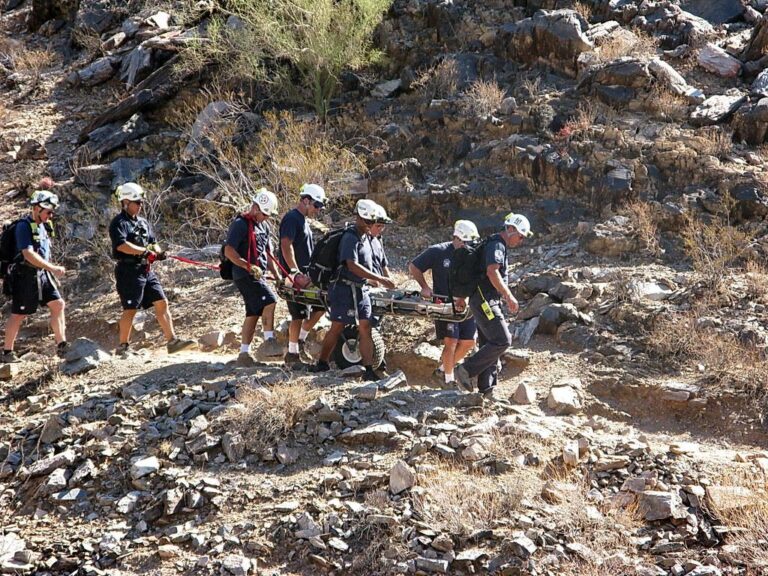Tragic Loss on Phoenix’s Camelback Mountain Highlights Hiking Risks and Safety Precautions
In a heartbreaking incident earlier this week, a hiker who was recently rescued from the well-traveled Echo Canyon Trail on Camelback Mountain in Phoenix has passed away, according to official reports. The rescue operation, which attracted considerable attention due to the trail’s popularity, underscores the inherent hazards even on familiar hiking paths. Authorities are actively investigating the circumstances surrounding the fatality and are urging outdoor enthusiasts to remain vigilant and well-prepared when exploring the region’s natural landscapes.
Emergency Response to Hiker’s Collapse on Camelback Mountain
Emergency teams were rapidly deployed after witnesses reported a hiker collapsing near the midpoint of the Echo Canyon Trail. The individual was found disoriented and unresponsive, prompting a coordinated rescue involving local sheriff deputies, paramedics, and specialized mountain rescue units. Despite the challenging terrain and soaring afternoon temperatures—recently recorded to reach highs of 105°F (40.5°C)—rescuers reached the victim within 40 minutes. Immediate medical attention was provided onsite before the hiker was airlifted to a nearby medical facility. Unfortunately, the victim later succumbed to their injuries.
| Detail | Information |
|---|---|
| Location | Echo Canyon Trail, Camelback Mountain, Phoenix, AZ |
| Response Time | Approximately 40 minutes |
| Rescue Personnel | Local sheriffs, paramedics, mountain rescue teams |
| Outcome | Victim airlifted; later died from injuries |
Obstacles Confronted by Rescue Teams in Mountain Emergencies
Mountain rescue operations are fraught with numerous challenges that complicate timely and effective responses. The rugged landscape of Camelback Mountain, characterized by steep slopes, loose rocks, and dense brush, often restricts access and slows down rescue efforts. Additionally, sudden weather shifts—such as unexpected thunderstorms or intense heat waves—pose significant risks to both victims and rescuers. In some cases, aerial evacuation becomes necessary, but this too can be hindered by adverse weather or limited landing zones.
Communication difficulties further exacerbate rescue challenges. Many sections of popular trails suffer from poor or nonexistent cellular coverage, delaying emergency notifications and complicating coordination between ground teams and command centers. Moreover, first responders must often perform rapid medical assessments and provide stabilization with limited equipment in these remote settings.
| Challenge | Effect | Countermeasure |
|---|---|---|
| Rough Terrain | Slows victim access | Deployment of all-terrain vehicles, rope systems |
| Unpredictable Weather | Endangers rescue teams | Continuous weather monitoring, aerial support |
| Communication Blackouts | Delays coordination | Use of satellite phones, portable radio repeaters |
| Limited Medical Resources | Complicates patient stabilization | Advanced first aid training, compact trauma kits |
Understanding Heat Exhaustion: A Major Threat for Desert Hikers
Medical experts warn that heat exhaustion remains a critical and often underestimated risk for hikers traversing Arizona’s desert trails. This condition arises when the body’s cooling mechanisms are overwhelmed by prolonged exposure to high temperatures combined with strenuous physical activity. Symptoms can escalate quickly, including profuse sweating, fatigue, dizziness, nausea, and in severe cases, loss of consciousness.
Recognizing early signs is vital to prevent progression to heat stroke, a life-threatening emergency. Recent studies indicate that heat-related illnesses account for nearly 70% of all medical emergencies on desert hiking trails during summer months.
Preventive strategies recommended by healthcare professionals include:
- Consuming sufficient water regularly to maintain hydration
- Wearing breathable, light-colored clothing and wide-brimmed hats
- Planning hikes during cooler parts of the day, such as early mornings or late afternoons
- Taking frequent breaks in shaded or cooler areas
- Listening to your body and avoiding overexertion during peak heat
| Symptom | Description | Recommended Immediate Action |
|---|---|---|
| Excessive Sweating | Body’s attempt to cool down | Seek shade and hydrate |
| Weakness or Dizziness | Feeling faint or unsteady | Rest and cool the body with water |
| Nausea | Upset stomach, possible vomiting | Stop activity and sip fluids slowly |
| Rapid Heartbeat | Elevated pulse rate | Seek medical attention if persistent |
Essential Safety Guidelines to Prevent Heat-Related Illness on Phoenix Trails
Given the extreme summer temperatures in Phoenix, hikers must take proactive steps to avoid heat-related health issues. Experts advise carrying at least one liter of water per hour of hiking and starting treks early to avoid the midday sun. Wearing moisture-wicking, light-colored clothing and a wide-brimmed hat can significantly reduce sun exposure. Applying broad-spectrum sunscreen with a high SPF and reapplying every two hours is also crucial to prevent sunburn, which impairs the body’s cooling ability.
Awareness of heat illness symptoms is key. If you or a companion experience dizziness, excessive sweating, nausea, or confusion, immediately seek shade, remove restrictive clothing, and hydrate slowly. Below is a practical checklist to enhance safety on popular Phoenix hiking routes:
- Check Weather Forecasts: Avoid hiking during extreme heat warnings.
- Dress Appropriately: Opt for loose, breathable fabrics in light colors.
- Stay Hydrated and Nourished: Bring water and electrolyte-rich snacks.
- Take Frequent Breaks: Rest in shaded or cooler spots regularly.
- Use the Buddy System: Never hike alone and inform someone of your itinerary.
| Symptom | Immediate Response |
|---|---|
| Dizziness | Rest and hydrate in shade |
| Excessive Sweating | Cool skin and drink fluids |
| Nausea | Stop hiking and sip fluids slowly |
| Confusion | Call emergency services immediately |
Final Thoughts: Prioritizing Safety on Arizona’s Trails
The recent fatality on Camelback Mountain serves as a poignant reminder that even well-known and frequently traveled hiking routes carry inherent risks. As investigations continue, local authorities emphasize the importance of preparation, awareness, and caution for all outdoor adventurers. Respecting the unpredictable nature of the environment and adhering to safety guidelines can help prevent tragedies and ensure that hiking remains a rewarding and safe experience for everyone.







